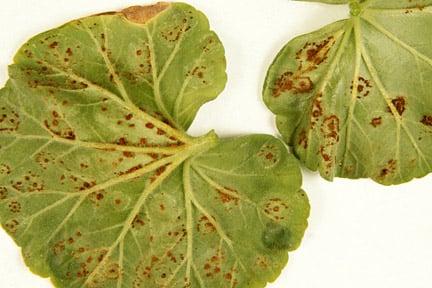
Quick facts
Common name - Pelargonium rust
Scientific name - Puccinia pelargonii-zonalis
Plants affected - Zonal pelargoniums
Main symptoms - Small yellow spots and dark brown pustules
Caused by - Fungus
Timing - All years indoors, during summer outdoors
What is pelargonium rust?
Rust is a disease of the leaves of zonal pelargoniums, caused by the fungus Puccinia pelargonii-zonalis.
This is a disease specific to zonal pelargoniums. Ivy-leaved pelargoniums are not affected. Symptoms occur all year indoors and during summer outdoors.
Symptoms
You may see the following symptoms:
- On leaves: Small yellow spots on the upper leaf surface corresponding initially to whitish blisters on the underside of the leaf. The blisters develop into brown, powdery masses of rust spores, often occurring in concentric rings. In severe attacks, the brown spore masses may also appear on the upper leaf surface
- Badly affected leaves turn yellow and fall, weakening the plant
Control
The RHS believes that avoiding pests, diseases and weeds by good practice in cultivation methods, selection, and encouraging or introducing natural enemies, should be the first line of control. If chemical controls are used, they should be used only in a minimal and highly targeted manner.
Non-chemical control
- Take care that newly acquired plants are disease-free. Unfortunately, the fungus can be present in the leaves for about two weeks before symptoms appear. Because of this it may be useful to keep new plants isolated for at least two weeks if there is a risk to other
- Keep the greenhouse well ventilated to improve air circulation and reduce . Avoid prolonged periods of leaf wetness
- If plants are heavily infected and weakened, it may be prudent to dispose of them and start again
Fungicides
The RHS recommends that you don't use fungicides. Fungicides (including organic types) may reduce , impact soil health and have wider adverse environmental effects. If you do intend to use a fungicide, please read the information given in the link and download below to ensure that use, storage and disposal of the product is done in a responsible and legally compliant manner.
The products listed in the ‘Fungicides for gardeners’ document below are legally available for use by home gardeners in the UK. This information is provided to avoid misuse of legal products and the use of unauthorised and untested products, which potentially has more serious consequences for the environment and wildlife than when products are used legally. Homemade products are not recommended as they are unregulated and usually untested.
Download
Fungicides for gardeners (Adobe Acrobat pdf document outlining fungicides available to gardeners)
Link
Biology
The fungus causing pelargonium rust is, like all rusts, a biotroph: it infects the host tissues for extended periods, feeding on the living cells. Unlike many rust diseases no alternate host is required to complete its life cycle.
Puccinia pelargonii-zonalis produces only two types of spore and only one of these, the rusty brown urediniospores, appear to be involved in the disease cycle. The other spore type is rare and has not been observed to germinate. The urediniospores are capable of surviving for several weeks in leaf debris.
The rusty brown spores are spread by wind and water splash and germinate on the leaves, immediately penetrating into the leaf tissues. The fungus forms feeding structures called haustoria, which extract from the leaf cells. Later the fungus forms fresh spores in pustules which burst out of the leaf surface.
The spores require moist conditions to germinate and infect, and the disease is often more severe during cooler months on overwintering plants under glass, but can also be very damaging outdoors during wet summers. Infection can also be spread via cuttings. Like many rust diseases, pelargonium rust can have a lengthy latent period (when the plant tissue is infected but no symptoms are yet visible). The latent period can frequently be as long as two weeks (sometimes much longer), and in this time from an infected batch may have been transported to many destinations.
This rust originates in southern Africa, but has now spread around most of the world. It was first detected in the UK in 1965.








